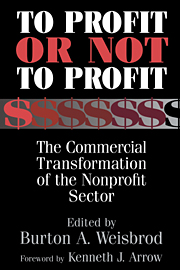Book contents
- Frontmatter
- Contents
- List of contributors
- Foreword by Kenneth J. Arrow
- Preface
- 1 The nonprofit mission and its financing: Growing links between nonprofits and the rest of the economy
- Part I Basic issues and perspective
- Part II Industry studies
- Part III Overview, conclusions, and public-policy issues
- 14 Commercialism among nonprofits: Objectives, opportunities, and constraints
- 15 Conclusions and public-policy issues: Commercialism and the road ahead
- Appendix: IRS Forms 990 and 990-T for nonprofit organizations
- References
- Index
15 - Conclusions and public-policy issues: Commercialism and the road ahead
Published online by Cambridge University Press: 30 November 2009
- Frontmatter
- Contents
- List of contributors
- Foreword by Kenneth J. Arrow
- Preface
- 1 The nonprofit mission and its financing: Growing links between nonprofits and the rest of the economy
- Part I Basic issues and perspective
- Part II Industry studies
- Part III Overview, conclusions, and public-policy issues
- 14 Commercialism among nonprofits: Objectives, opportunities, and constraints
- 15 Conclusions and public-policy issues: Commercialism and the road ahead
- Appendix: IRS Forms 990 and 990-T for nonprofit organizations
- References
- Index
Summary
Introduction
Should anyone care, we asked in Chapter 1, whether the nonprofit sector becomes increasingly commercial? The answer is yes, many people should care: taxpayers, who are affected by the subsidies to nonprofits; consumers of these organizations' services; governmental policymakers, as stewards for the public interest; owners of private firms, which are affected by nonprofits' activities; and nonprofit managers and directors, who are responsible for their organizations. We have surveyed the landscape of the nonprofit sector, examining why revenue-generating sources are changing, what forms they are taking, and what the consequences are of their use.
We turn next to an overview of our findings, focusing on the building blocks of our analyses: goals (or mission) and constraints. That discussion, which constitutes the majority of this chapter, is followed by a section identifying a number of issues that call for targeted research, and another on what our findings imply for the development of sound public policy toward the nonprofit sector and its financing. In short, we now take stock of what has been learned and what its implications are – for research and for public policy. A final section peers into the future of the nonprofit sector in light of its search for revenue.
What has been learned about nonprofits' commercialism?
Overview
The causes and consequences of commercialization are not abstract issues. Nonprofit organizations' commercial activities are bringing revolutionary changes in traditional behavior, and in the process they are blurring the distinction between nonprofits and private firms.
- Type
- Chapter
- Information
- To Profit or Not to ProfitThe Commercial Transformation of the Nonprofit Sector, pp. 287 - 305Publisher: Cambridge University PressPrint publication year: 1998
- 10
- Cited by



